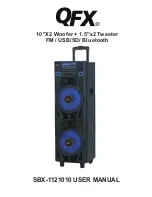
2.
Environmental Information:
This product complies with international directives, including but not limited to:
i. The Restriction of Hazardous Substances (RoHS) in electrical and electronic equipment,
ii. The Registration, Evaluation, Authorisation and restriction of Chemicals (REACH)
iii. The disposal of Waste Electrical and Electronic Equipment (WEEE).
Please consult your local waste disposal authority for guidance on how properly to recycle or
dispose of this product.
Please re-use the draw-string bags. They are suitable for carrying various items. All bags
should be kept away from babies and small children
.
5.
Connections
All connections should be made with the audio equipment switched off.
Ensure terminals to each loudspeaker are correctly connected. Follow our wiring cable
diagram. Connect the positive feed from the amplifier to the red loudspeaker terminal.
The negative amplifier feed connects to the black terminal on the loudspeaker.
6.
Amplifier and Source Recommendations
Nearly all Loudspeakers are passive components. They can only perform at their best if
amplification, source and cable components are of high quality.
Careful and thoughtful choice of a suitable amplifier should optimise performance.
Suitable amplifiers will range from: Class A/B 50 Watts to 100 Watts per channel at 8 Ohms.
Class A from 12 Watts to 25 Watts per channel at 8 Ohms and Class D from 30 Watts to 60
Watts per channel at 8 Ohms. Amplifier design and performance varies so these
recommendations can only be a guide.
Source components such as CD players, DAC’s and similar vary in performance quality.
Take time to research better quality components and recordings. Cables can also effect
performance. Be prepared to experiment with cables to suit your listening tastes.
7.
Running In
Markaudio-Sota speaker drive components are engineered to tighter tolerances than
most other units. Careful thoughtful running-in and general operation will be rewarded by
many years of faithful service. Use low volumes for the first 100 hours to allow the driver
suspensions to adjust to their normal tolerance.
Over-driving loudspeakers (high volumes) risks damaging the drive units. It is also a major
cause of human loss of hearing.
4.
Speaker Positioning
Room acoustic performance varies. Adjusting the speaker positions may further improve the
sound quality. Typical placement of loudspeakers is either side of a TV. Start by placing the
loudspeakers approximately 2.5 metres to 3 metres apart with a minimum clearance from a
back wall of 100mm. Experiment by angling the loudspeakers toward or away from your
central listening position to suit your tastes.
3.
Speaker Installation:
The speaker is primarily designed to be
mounted on a dedicated floor stand
(FS-V1) but may be placed on a shelf if
preferred. See the separate FS-V1
instructions for stand assembly.
Wind the feet into each corner (1), adjust
the feet using the locking adjustment
wheel. Add the support discs to avoid
damaging surfaces (supplied) and final
level the loudspeaker (2).
Ensure shelves are strong enough to
properly support the weight of each
loudspeaker.
Step 1
Step 2




















